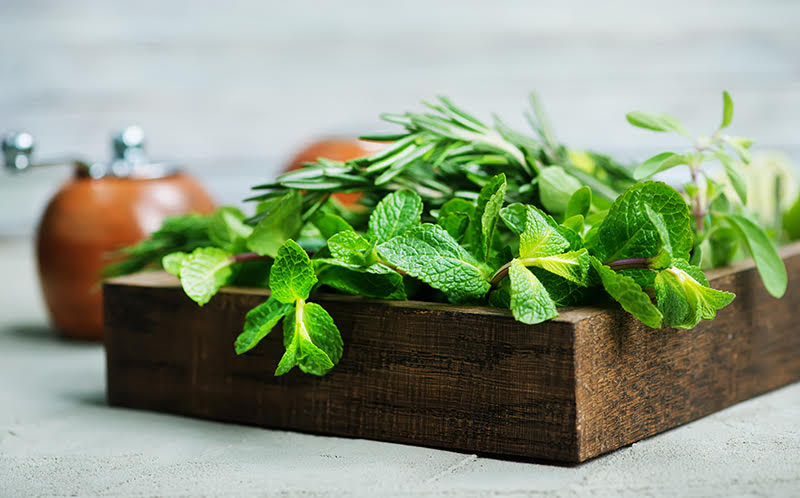
A good chef knows that herbs and spices can make or break a dish. Growing your own plants in a garden will supply you with fresh ingredients that can take your home cooked meals to the next level.
If it’s chilly outside where you are, or if you don’t have enough space for an outdoor garden, don’t fret. You can create an indoor garden for all your cooking needs.
Popular Plant Options
The sheer number of plant options you have can be overwhelming. But for the home chef, it’s best to stick to plants and herbs that can be used for a variety of dishes.
Basil
You can buy potted basil at the grocery store, or you can choose to start from seed.
This herb is used in everything from pasta sauce to fancy cocktails, and it can be easily grown indoors. Basil loves a lot of sun, so be sure to position the pot or the container close to a sunny window.
Bay Leaves
Bay leaves have a complex flavor that is both sweet and bitter. They’re often used in dishes that have long cook-times, like in stews, soups, and sauces. Steeping bay leaves in warm dishes for long periods help release the amazing flavor.
Bay plants are shrub-like perennials that grow well in containers. The plants may need to be pruned as they can get quite large and overcrowded. Overcrowding is bad for the bay plant, as it needs plenty of air to grow healthily.
Oregano
The smell and taste of oregano brings back great memories of pizza, pasta, and comfort food. Oregano is aromatic, delicious, and an easy addition to your indoor garden.
It’s recommended to begin your indoor oregano plant with a tip you cut from an outdoor plant. Once planted, oregano does well in a south-facing window.
Parsley
You can start a parsley plant from either seeds or from an existing plant. If you start from seed, it’s a good idea to soak them in warm water first.
Parsley is another herb that can be implemented in a great variety of dishes so that your indoor garden will be put to good use. You can use it in meat marinades, in a pasta sauce, in hummus or other spreads, and even just as a garnish.
Rosemary
Rosemary is a strong smelling, fresh, and pungent-flavored herb. Wherever you grow it, it will fill the whole room with a fresh smell that will have you dying to cook with it. You don’t need to grow as much rosemary as some other herbs because of its strong flavor.
Rosemary does best in a south-facing window and can be used in many different dishes: try it with garlic and olive oil to give fish and other meat great flavor. Or you could go classic and throw it in sauce, pasta dishes, and pizza.
Mint
Many indoor herbs are used primarily in savory dishes. Mint, on the other hand, is able to be used in both sweet and savory dishes. You can make mint chocolate chip ice cream, mint cocktails, mint marinades for meat, and you can even throw it in a smoothie for a refreshing kick.
Many have better luck growing mint indoors versus outdoors. Mint grows quickly and can spread throughout your outdoor space, taking over every spot in the garden. Growing it indoors allows you to tame it to a single container.
Indoor Gardening Tips
Once you’ve selected the plants you want to include in your indoor garden, it’s time to focus on how you can keep those plants healthy and alive.
Pay Attention to Positioning
Some plants prefer direct sunlight, some like south-facing windows, and some don’t like sun at all. The positioning of the plant will significantly affect its growth and health. Be sure to do your research and position your plants so they can thrive.
Keep the Plants Away from Drafts
Drafts from your heater, from the air conditioner, or even from a door or window can be bad for your indoor garden. Fluctuating temperatures can damage the plants, and even kill them if you’re not careful.
Don’t Over Water Your Plants
In your desire to keep your plant healthy and take good care of your garden, it can be tempting to water your plants constantly. A little extra water can’t hurt, right?
Actually, it can hurt a lot. Over-watering can over-saturate the soil and the roots of the plant, which blocks it from getting nutrients and oxygen. Over-watering is one of the top causes of plant death for indoor gardeners, so be aware of how much you’re watering.
To test whether the plant needs water, touch your finger to the soil. If you lift your finger and there’s no soil stuck to it, then it’s time to water. If there’s soil on your finger, that means the soil is moist and has enough water already.
This post is intended for informational purposes only and should not be taken as professional advice. The point of view and opinions expressed in this post are those of the author and do not necessarily reflect the position of Realty Executives International.
This post was written for Realty Executives by Elliot Walsh. Elliot is a dual-degree graduate from the University of Rochester with a B.S in Cell Biology and a B.A in English Literature. He is a full-time freelance writer from Boston, specializing in veganism, humor, and health. His articles have appeared in The Rival Rochester and his work experience can be found here: www.linkedin.com/in/ewalsh17.
